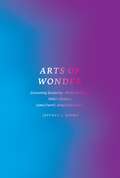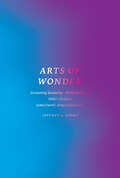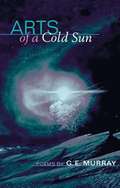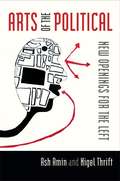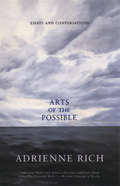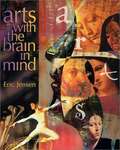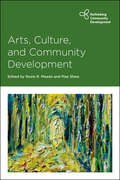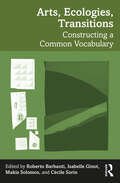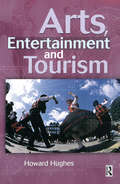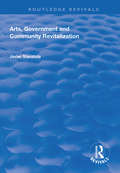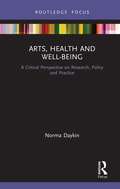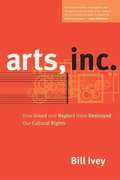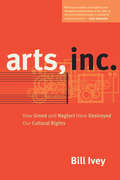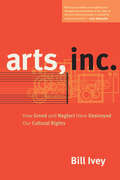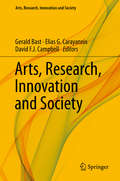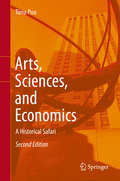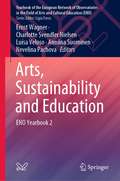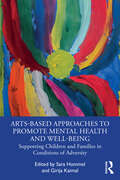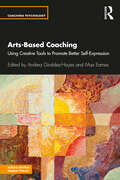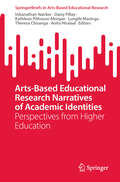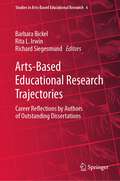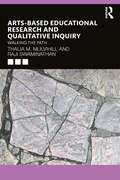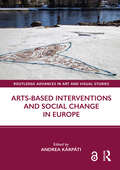- Table View
- List View
Arts of Wonder: Enchanting Secularity--Walter De Maria, Diller + Scofidio, James Turrell, Andy Goldsworthy
by Jeffrey L. Kosky"The fate of our times is characterized by rationalization and intellectualization and, above all, by 'the disenchantment of the world. '" Max Weber's statement remains a dominant interpretation of the modern condition: the increasing capabilities of knowledge and science have banished mysteries, leaving a world that can be mastered technically and intellectually. And though this idea seems empowering, many people have become disenchanted with modern disenchantment. Using intimate encounters with works of art to explore disenchantment and the possibilities of re-enchantment, Arts of Wonder addresses questions about the nature of humanity, the world, and God in the wake of Weber's diagnosis of modernity. Jeffrey L. Kosky focuses on a handful of artists--Walter De Maria, Diller + Scofidio, James Turrell, and Andy Goldworthy--to show how they introduce spaces hospitable to mystery and wonder, redemption and revelation, and transcendence and creation. What might be thought of as religious longings, he argues, are crucial aspects of enchanting secularity when developed through encounters with these works of art. Developing a model of religion that might be significant to secular culture, Kosky shows how this model can be employed to deepen interpretation of the art we usually view as representing secular modernity. A thoughtful dialogue between philosophy and art, Arts of Wonder will catch the eye of readers of art and religion, philosophy of religion, and art criticism.
Arts of Wonder: Enchanting Secularity—Walter De Maria, Diller + Scofidio, James Turrell, Andy Goldsworthy (Religion And Postmodernism Ser.)
by Jeffrey L. Kosky“The fate of our times is characterized by rationalization and intellectualization and, above all, by ‘the disenchantment of the world.’” Max Weber’s statement remains a dominant interpretation of the modern condition: the increasing capabilities of knowledge and science have banished mysteries, leaving a world that can be mastered technically and intellectually. And though this idea seems empowering, many people have become disenchanted with modern disenchantment. Using intimate encounters with works of art to explore disenchantment and the possibilities of re-enchantment, Arts of Wonder addresses questions about the nature of humanity, the world, and God in the wake of Weber’s diagnosis of modernity. Jeffrey L. Kosky focuses on a handful of artists—Walter De Maria, Diller + Scofidio, James Turrell, and Andy Goldsworthy—to show how they introduce spaces hospitable to mystery and wonder, redemption and revelation, and transcendence and creation. What might be thought of as religious longings, he argues, are crucial aspects of enchanting secularity when developed through encounters with these works of art. Developing a model of religion that might be significant to secular culture, Kosky shows how this model can be employed to deepen interpretation of the art we usually view as representing secular modernity. A thoughtful dialogue between philosophy and art, Arts of Wonder will catch the eye of readers of art and religion, philosophy of religion, and art criticism.
Arts of a Cold Sun: POEMS
by G. E. MurrayIn these poems, G. E. Murray blends the colors of the soul with those of the world it brushes up against, exploring the ways in which art, both as possession and possessor, informs perception. Viewing his subjects sometimes from airplane altitude, sometimes from the intimacy of a shared restaurant table, Murray crafts "true stories about color," narratives of dislocation and belonging that invite readers to question their own relationship to art. Included in this volume is a long sequential poem titled "The Seconds," which Murray composed across the second days of thirteen months. The rhythms of this diary-as-poem seize the tensions of shifting times and locales, capturing the essences of moments that are at once chosen and arbitrary. "Codes toward an Incidental City," the sequence that closes the book, is a confederacy of forty poems that delve into the concrete familiarities and mythologies of urban landscapes, illuminating the ecstasies of city life.
Arts of the Political: New Openings for the Left
by Ash Amin Thrift NigelIn the West, "the Left," understood as a loose conglomeration of interests centered around the goal of a fairer and more equal society, still struggles to make its voice heard and its influence felt, even amid an overwhelming global recession. In Arts of the Political: New Openings for the Left, Ash Amin and Nigel Thrift argue that only by broadening the domain of what is considered political and what can be made into politics will the Left be able to respond forcefully to injustice and inequality. In particular, the Left requires a more imaginative and experimental approach to the politics of creating a better society. The authors propose three political arts that they consider crucial to transforming the Left: boosting invention, leveraging organization, and mobilizing affect. They maintain that successful Left political movements tend to surpass traditional notions of politics and open up political agency to these kinds of considerations. In other words, rather than providing another blueprint for the future, Amin and Thrift concentrate their attention on a more modest examination of the conduct of politics itself and the ways that it can be made more effective.
Arts of the Possible: Essays and Conversations
by Adrienne Rich"Adrienne Rich's new prose collection could have been titled The Essential Rich."--Women's Review of Books These essays trace a distinguished writer's engagement with her time, her arguments with herself and others. "I am a poet who knows the social power of poetry, a United States citizen who knows herself irrevocably tangled in her society's hopes, arrogance, and despair," Adrienne Rich writes. The essays in Arts of the Possible search for possibilities beyond a compromised, degraded system, seeking to imagine something else. They call on the fluidity of the imagination, from poetic vision to social justice, from the badlands of political demoralization to an art that might wound, that may open scars when engaged in its work, but will finally suture and not tear apart. This volume collects Rich's essays from the last decade of the twentieth century, including four earlier essays, as well as several conversations that go further than the usual interview. Also included is her essay explaining her reasons for declining the National Medal for the Arts. "The work is inspired and inspiring."--Alicia Ostriker "[S]o clear and clean and thorough. I learn from her again and again."--Grace Paley
Arts with the Brain in Mind
by Eric JensenHow do the arts stack up as a major discipline? What is their effect on the brain, learning, and human development? How might schools best implement and assess an arts program? Eric Jensen answers these questions--and more--in this book. To push for higher standards of learning, many policymakers are eliminating arts programs. To Jensen, that's a mistake. This book presents the definitive case, based on what we know about the brain and learning, for making arts a core part of the basic curriculum and thoughtfully integrating them into every subject. Separate chapters address musical, visual, and kinesthetic arts in ways that reveal their influence on learning. What are the effects of a fully implemented arts program? The evidence points to the following: * Fewer dropouts* Higher attendance* Better team players * An increased love of learning* Greater student dignity* Enhanced creativity* A more prepared citizen for the workplace of tomorrow* Greater cultural awareness as a bonus To Jensen, it's not a matter of choosing, say, the musical arts over the kinesthetic. Rather, ask what kind of art makes sense for what purposes. How much time per day? At what ages? What kind of music? What kind of movement? Should the arts be required? How do we assess arts programs? In answering these real-world questions, Jensen provides dozens of practical, detailed suggestions for incorporating the arts into every classroom.
Arts, Culture and Community Development (Rethinking Community Development)
by Rosie R. Meade and Mae ShawHow and why are arts and cultural practices meaningful to communities? Highlighting examples from Lebanon, Latin America, China, Ireland, India, Sri Lanka and beyond, this exciting book explores the relationship between the arts, culture and community development. Academics and practitioners from six continents discuss how diverse communities understand, re-imagine or seek to change personal, cultural, social, economic or political conditions while using the arts as their means and spaces of engagement. Investigating the theory and practice of ‘cultural democracy’, this book explores a range of aesthetic forms including song, music, muralism, theatre, dance, and circus arts.
Arts, Culture, and Blindness: A Study of Blind Students in the Visual Arts
by Simon HayhoeThis book explores one of the most powerful myths in modern society: the myth that blind people are incapable of understanding and creating visual arts.
Arts, Ecologies, Transitions: Constructing a Common Vocabulary
by Makis Solomos Roberto Barbanti Isabelle Ginot Cécile SorinArts, Ecologies, Transitions provides in-depth insights into how aesthetic relations and current artistic practices are fundamentally ecological and intrinsically connected to the world. As art is created in a given historic temporality, it presents specific modalities of productive and sensory relations to the world. With contributions from 49 researchers, this book tracks evolutions in the arts that demonstrate an awareness of the environmental, economic, social, and political crises. It proposes interdisciplinary approaches to art that clarify the multiple relationships between art and ecology through an exploration of key concepts such as collapsonauts, degrowth, place, recycling, and walking art. All the artistic fields are addressed from the visual arts, theatre, dance, music and sound art, cinema, and photography – including those that are rarely represented in research such as digital creation or graphic design – to showcase the diversity of artistic practices in transition.Through original research this book presents ideas in an accessible format and will be of interest to students and researchers in the fields of environmental studies, ecology, geography, cultural studies, architecture, performance studies, visual arts, cinema, music, and literature studies.
Arts, Entertainment and Tourism
by Howard Hughes'Arts, Entertainment and Tourism' is a pioneering text that, by focusing on the consumer, investigates the relationship between these 3 industries and how this relationship can be developed to its best competitive advantage. Issue-led, this text draws on appropriate disciplines rather than using one single approach, to examine issues in arts and entertainment within the framework of cultural tourism.Written to meet the needs of students studying on management courses in the arts, tourism and leisure, 'Arts, Entertainment and Tourism':* Describes the general arts and tourism background* Identifies a framework for analysis that acknowledges differing levels of interest in the arts and entertainment* Discusses the arts and entertainment that feature (past and present) in tourism * Examines the reasons why the arts, entertainment and tourism have an interest in each other and how they go about developing the relationship* Examines the relationship: are there tourists in audiences and do the arts and entertainment attract tourists to a destination?* Evaluates the wider effects (good and bad) on both the arts and tourism* Discusses the direction of future developments by arts and tourism organizations and for future research
Arts, Government and Community Revitalization (Routledge Revivals)
by Javier StanziolaFirst published in 1999, this book goes beyond the standard economic tools used to evaluate the effectiveness of arts in redevelopment processes. It assumes that the sectors involved in the process of arts-led community revitalization (artists, non-profit organizations, government and for-profit firms) act upon the economic structure and initiate a resurgence path. This assumption allows us to study the political and economic interaction among these sectors, understand their incentives and define and explore their boundaries. This book explores the 1) cultural and regeneration reasons for revitalization; 2) sources of funds; 3) political interaction; 4) definition and estimation of output; 5) evaluation of output; 6) estimation of coefficients and multipliers effects obtained from input-output tables.
Arts, Health and Well-Being: A Critical Perspective on Research, Policy and Practice
by Norma DaykinThis important book develops a critical understanding of the bridging of arts and health domains, drawing on models and perspectives from social sciences to develop the case for arts and health as a social movement. This interdisciplinary perspective offers a new research agenda that can help to inform future developments and sustainability in arts, health and well-being. Daykin begins with an overview of the current evidence base and a review of current challenges for research, policy and practice. Later chapters explore the international field of health and the arts; arts, with well-being as a social movement; and boundary work and the role of boundary objects in the field. The book also includes sections summarising research findings and evidence in arts and health research and examples from specific research projects conducted by the author, chosen to highlight particularly widespread challenges across many arts, health and well-being contexts. Arts, Health and Well-Being: A Critical Perspective on Research, Policy and Practice is valuable reading for students in sociology, psychology, social work, nursing, psychiatry, creative and performing arts, public health and policymakers and practitioners in these fields.
Arts, Inc.: How Greed and Neglect Have Destroyed Our Cultural Rights
by Bill IveyIn this impassioned and persuasive book, Bill Ivey assesses the current state of the arts in America and finds cause for alarm. Even as he celebrates our ever-emerging culture and the way it enriches our lives here at home while spreading the dream of democracy around the world, he points to a looming crisis.
Arts, Inc.: How Greed and Neglect Have Destroyed Our Cultural Rights
by Bill IveyIn this impassioned and persuasive book, Bill Ivey, the former chairman of the National Endowment for the Arts, assesses the current state of the arts in America and finds cause for alarm. Even as he celebrates our ever-emerging culture and the way it enriches our lives here at home while spreading the dream of democracy around the world, he points to a looming crisis. The expanding footprint of copyright, an unconstrained arts industry marketplace, and a government unwilling to engage culture as a serious arena for public policy have come together to undermine art, artistry, and cultural heritage--the expressive life of America. In eight succinct chapters, Ivey blends personal and professional memoir, policy analysis, and deeply held convictions to explore and define a coordinated vision for art, culture, and expression in American life.
Arts, Inc.: How Greed and Neglect Have Destroyed Our Cultural Rights
by Bill IveyIn this impassioned and persuasive book, Bill Ivey, the former chairman of the National Endowment for the Arts, assesses the current state of the arts in America and finds cause for alarm. Even as he celebrates our ever-emerging culture and the way it enriches our lives here at home while spreading the dream of democracy around the world, he points to a looming crisis. The expanding footprint of copyright, an unconstrained arts industry marketplace, and a government unwilling to engage culture as a serious arena for public policy have come together to undermine art, artistry, and cultural heritage—the expressive life of America. In eight succinct chapters, Ivey blends personal and professional memoir, policy analysis, and deeply held convictions to explore and define a coordinated vision for art, culture, and expression in American life.
Arts, Research, Innovation and Society (Arts, Research, Innovation and Society)
by Elias G. Carayannis David F. J. Campbell Gerald BastThis book explores - at the macro, meso and micro levels and in terms of qualitative as well as quantitative studies - theories, policies and practices about the contributions of artistic research and innovations towards defining new forms of knowledge, knowledge production, as well as knowledge diffusion, absorption and use. Artistic research, artistic innovations and arts-based innovations have been major transformers, as well as disruptors, of the ways in which societies, economies, and political systems perform. Ramifications here refer to the epistemic socio-economic, socio-political and socio-technical base and aesthetic considerations on the one hand, as well as to strategies, policies, and practices on the other, including sustainable enterprise excellence, considerations in the context of knowledge economies, societies and democracies. Creativity in general, and the arts in particular, are increasingly recognized as drivers of cultural, economic, political, social, and scientific innovation and development. This book examines how one could derive and develop insights in these areas from the four vantage points of Arts, Research, Innovation and Society. Among the principal questions that are examined include: - Could and should artists be researchers? - How are the systems of the Arts and Sciences connected and/or disconnected? - What is the impact of the arts in societal development? - How are the Arts interrelated with the mechanisms of generating social, scientific and economic innovation? As the inaugural book in the Arts, Research, Innovation and Society series, this book uses a thematically wide spectrum that serves as a general frame of reference for the entire series of books to come.
Arts, Sciences, and Economics: A Historical Safari
by Tönu PuuThis book deals with the economic aspects of changing attitudes in arts and sciences. The effects of the public good character of culture, along with the very long production period and lifetime for its products, are emphasized, since both contribute to the failure of normal market solutions. Embodiment of ideas and the consequences of modern reproduction technology for protection of property rights are closely examined. The evolution within arts and sciences, which often seems to return to previously scrapped ideals, is illustrated by detailed case studies, in which the importance of changing tastes, rather than progress proper, is emphasized. The author attempts an understanding for this using Darwinian evolution in combination with modern mathematical complexity theory, expressed in terms accessible to the general reader. The second edition is extended and updated especially as regards the illustration material.
Arts, Sustainability and Education: ENO Yearbook 2 (Yearbook of the European Network of Observatories in the Field of Arts and Cultural Education (ENO))
by Luísa Veloso Charlotte Svendler Nielsen Ernst Wagner Anniina Suominen Nevelina PachovaThis book explores the potential of arts and cultural education to contribute to on-going efforts to promote Education for Sustainable Development (ESD) in line with UNESCO’s conceptualizations of the field. It builds on the experiences of arts educators working to build sustainable futures and portrays new and innovative approaches. Chapters comprise case studies that combine arts, culture, sustainable thinking and practices. They also include research from historical perspectives, evaluations of public policy measures and offer theoretical approaches and methodologies. The book unfolds the possible relationships between arts and cultural education and Education for Sustainable Development.
Arts-Based Approaches to Promote Mental Health and Well-Being: Supporting Children and Families in Conditions of Adversity
by Girija Kaimal Sara HommelThis book provides insights on how creative and expressive approaches can promote psychosocial well-being among children, youth, and their caregivers living in conditions of adversity around the world.Arts-based psychosocial approaches give children a means to tap into their strengths as well as adaptively communicate and process experiences in ways that promote their own and overall family well-being. Offering an overview of the impact of adverse childhood experiences on lifelong health and functioning and how arts-based approaches can be protective, this book discusses relevant theory and research, as well as case studies and findings from mixed methods program evaluations. Examples from the Healing and Education Through the Arts (HEART) initiative from Save the Children are discussed in depth, and demonstrate the benefits of creative self-expression among children and families in the most challenging environments around the world.Creative arts therapists, public health professionals, education specialists, policymakers, and humanitarian groups seeking to provide cost-effective support to communities in need will find, in this book, insights on the impact of large-scale arts-based interventions in a range of public health and education settings.
Arts-Based Coaching: Using Creative Tools to Promote Better Self-Expression (Coaching Psychology)
by Andrea Giraldez-Hayes Max EamesThis book, written in an accessible way by leading experts in the field, offers a comprehensive exploration of arts integration in coaching through the lenses of positive and health psychology.Drawing together international experts and interdisciplinary perspectives, including health and neuroscience, the book explores the intersection of positive psychology and the arts, offering insights and strategies for using art to promote personal growth. The chapters in this book weave theory into practice, condense research and theoretical concepts into straightforward frameworks, and offer easily understandable ideas and examples. It provides a theoretical rationale for various art forms, including poetry, music, visual arts, dance, cinema, and photography. Each chapter includes case studies to present practical ways in which arts can enhance coaching conversations.Arts-Based Coaching is a practical guide that will interest coaching psychologists, coaches, dual practitioners offering therapeutic coaching, leaders, educators, and other professionals using coaching in their professional practice, as well as course leaders and students in coaching and coaching psychology.
Arts-Based Educational Research Narratives of Academic Identities: Perspectives from Higher Education (SpringerBriefs in Arts-Based Educational Research)
by Kathleen Pithouse-Morgan Daisy Pillay Inbanathan Naicker Lungile Masinga Theresa Chisanga Anita HiralaalThis book delves into the complexities of being and becoming an academic in higher education. Inspired by the arts, the book introduces new voices and insights to scholarly discussions about what constitutes data and analysis in higher education research. It demonstrates ABER’s ability to shape and critique academic identity narratives in response to pressing problems and dilemmas in higher education. The book includes exemplars from studies conducted primarily in South African contexts and led by South African researchers. It explores diverse modes, including collage, digital artwork, letter writing, metaphor, creative nonfiction, and theatre-making. Contributions from expert scholars in Canada and the USA supplement this research and show how it has been enriched by critical transcontinental conversations. The authors offer new perspectives on the entwined and complex relationship between the ABER, narratives, and identities.
Arts-Based Educational Research Trajectories: Career Reflections by Authors of Outstanding Dissertations (Studies in Arts-Based Educational Research #6)
by Rita L. Irwin Richard Siegesmund Barbara BickelThis book offers reflections from Arts-Based Educational Research (ABER) scholars who, since 2005, were awarded the American Educational Research Association ABER Special Interest Group's Outstanding Dissertation Award. The book includes essays from ten awardees who, across diverse artistic disciplines, share how their ABER careers evolve and succeed—inspiring insights into the possibilities of ABER. It also examines the essential role of mentorship in the academy that supports and expands ABER scholarship. Drawing from dissertation exemplars in the field, this book allows readers to look at how ABER scholars learn with the world while creatively researching and teaching in innovative ways
Arts-Based Educational Research and Qualitative Inquiry: Walking the Path
by Raji Swaminathan Thalia M. MulvihillArts-Based Educational Research and Qualitative Inquiry introduces novice qualitative researchers, within education and related fields, to arts-based educational research (ABER). Abundant prompts and exercises are provided to help readers apply the concepts and experiment with various applications of the ideas presented. The authors walk the path with novice researchers offering a variety of approaches to the practice of arts-based methods, while providing a guided overview of ABER, and include pedagogical features in each chapter. Exercises are designed to assist educational researchers who wish to expand their repertoire of methodologies. The authors also weave into the discussion the possibilities and limitations of many types of arts-based methods while introducing readers to the growing methodological literature. By offering a tapestry of ways to engage the novice researcher, the book illustrates that it is not always possible to separate cognitive findings from aesthetic knowing. This book will help qualitative researchers to expand their methodologies to include arts-based approaches to their projects and by doing so reshape their identities as qualitative researchers. It also offers some evaluative criteria and tool kits for experimenting with various arts and educational research.
Arts-Based Interventions and Social Change in Europe (Routledge Advances in Art and Visual Studies)
by Andrea KárpátiThis book presents 23 successful arts-based efforts to respond to social problems experienced by disadvantaged communities. The arts are a powerful means of fighting discrimination, marginalisation, neglect and even poverty. The educational programmes described in these chapters help stakeholders find solutions which are research-based, adaptable, repeatable and sustainable. Social problems that are addressed in this book include children living with physical challenges; suffering from financial and educational poverty; elderly women suffering from solitude; migrants facing a strange and not always welcoming cultural context; Roma youth fighting negative stereotypes and many more. Revealing the interconnectedness between social, economic and cultural exclusion, contributors planned interventions to develop skills, strengthen identities and build communities. This book will be of interest to scholars working in the visual arts, art education, design education, drama and theatre education and museum pedagogy. The Open Access version of this book, available at http://www.taylorfrancis.com, has been made available under a Creative Commons [Attribution-Non Commercial-No Derivatives (CC-BY-NC-ND)] 4.0 license.
